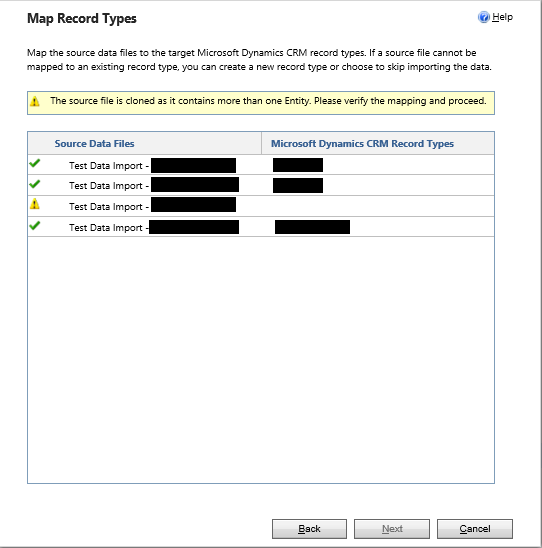As part of a recent project I have been involved in, one of the requirements was to facilitate a bulk data import process via a single import spreadsheet, which would then create several different CRM Entity records at once. I was already aware of the Bulk Data Import feature within CRM, and the ability to create pre-defined data maps via the GUI interface; what I wasn’t aware of was that there is also a means of creating the very same data maps via the SDK or an .xml import. This was a pleasant surprise to say the least and, from the looks of it online, there is very little in the way of resource available for what is, arguably, a very powerful out of the box feature within Dynamics CRM. Expect a future blog post from me that dives a bit deeper into this subject, as I think the capabilities of this tool could fit a variety of differing requirements; if only the instructions within the SDK were a bit more clearer when it comes to working with the raw data map .xml!
Whilst attempting to perform a proof of concept test, I uploaded a data map .xml into CRM, which contained references to four different entities. When I then attempted to run the data import using a test file, I encountered a strange issue which meant I could not proceed with the import. This occurred when CRM attempted to map the record types specified as part of the data map:
Can you spot the two issues?
The first, more obvious, problem is the yellow triangle on the 3rd entity option and the fact that the Record Type is empty. Whereas the 3 other options will display clearly the Display Names of the entities (e.g. Account, Lead), the Display Name of the problematic entity is not visible at all.
The more eagle-eyed readers may also have spotted the second, more serious issue; the next button is grayed out, meaning we have no way in which to move to next step as part of the data import. With no means of figuring out, exactly, what may be causing the problem based on the above screen, you can potentially expect a long-haul investigation to commence.
As it turns out, the issue was both simple and frustrating in equal measures. It turns out that because the third entity on the list of the above had the exact same Display Name value as another entity within the system, CRM got confused and was unable to display and map with the correct entity. So, for example, lets say you create a custom entity to record information relating to houses, called “Property”, with a Name of “new_property”. Without perhaps realising, CRM already has a system entity called “Property”, with a Name of “dynamicproperty”. It doesn’t matter that the Names of the entities are completely different; so long as the Display Names are, then you will encounter the same issue as highlighted above. So, after renaming the entity concerned with a unique Display Name (don’t forget to publish!), I was able to proceed successfully through the data import wizard.
So why is this frustrating? If, like me, you have worked with CRM for some time, your first assumption would be that the system would always rely on the Name of objects when it comes to determining unique entities, attributes etc. The above appears to be the exception to the rule, and is frustrating for the fact that it throws out of the window any assumed experience when it comes to working under the hood of CRM. Perhaps it was (fairly) assumed that, because the logical names must always be unique for entities, that the data map feature could just use the Display Name as opposed to Name when attempting to map record types. I would expect that CRM is performing some kind of query behind the scene at the above stage of the Data Import wizard, and that the Display Name field value is included as parameter for all entities included in the data map. In summary, I would suggest that this is a minor bug, but something that would be difficult to encounter as part of regular CRM use.
Hopefully the above post will help prevent anyone else from spending 6+ hours from figuring out just what in the hell is going on. 🙂 As a final side note, what this problem and solution demonstrates is an excellent best practice lesson to avoid; be sure to provide distinct Display Names to your custom entities.

